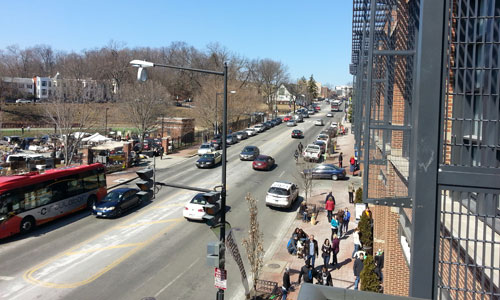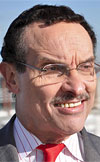“Stay the course” or “pivot”? Gray and Evans disagree about the ill-fated Wisconsin Avenue median
In 2012, DC changed the traffic patterns on Wisconsin Avenue in Glover Park to make it more friendly to pedestrians, then reversed course following strong complaints from many Georgetown residents including Councilmember Jack Evans. The issue came up in my interviews with Evans and Mayor Vince Gray.
I asked every candidate about the way the government can spend a lot of time planning a project, build community support, and still then later run into a lot of people who say they never heard about it or want to block it. Gray brought up this project in his response. He said,
We’ve seen in some parts of the city when a lane was changed and it was done with the concurrence of the people who lived in that area, who then railed against it in the aftermath and now it’s being put back like it was.
I think that you’ve got to stay the course. I happen to live on a street that was changed, where when people saw a change there was enormous negative reaction to it: Branch Avenue, which went from being two not sufficiently wide lanes on either side of the street, in my opinion — we saw lots of accidents there — to being one lane on either side. There were people that were up in arms. They wanted to put it back like it was. Now, people have adapted. It’s taken a number of years, no question about that, but people have adapted.
We have to work with communities around what do these proposals mean for their lives. Make sure there’s community input on how we get to the answer. And then once we do, we’ve got to stay the course if we believe, earnestly, these changes will make life better for folks.
People hate sitting in traffic. The answer is not to give more streets. The answer is to give other options to folks, other ways of traveling, other methods of traveling, and then you’ve got to swallow hard and stay with it.
Jack Evans disagrees. I asked him specifically about the Glover Park issue, and he said,
It was a complete disaster … Even the ANC chair, Brian Cohen who was the spearhead of it, and Jackie Blumenthal came to the position that it was a complete disaster. It wasn’t just me, it was everyone who realized that narrowing Wisconsin Avenue to 1 lane going north in rush hour just wasn’t working. You were backing traffic all the way past the Safeway all the way to R Street, and that wasn’t working for anybody.
I think the lesson that we take from that is they try something that doesn’t work, but can then pivot and maneuver rather than sticking to something that was just causing chaos. What you were doing, as you know, by having that center lane with stripes on it, people were starting to cut around, creating a very dangerous situation. I’m glad that people were starting to recognize that.
To be precise, the plan did not make Wisconsin Avenue 1 lane at rush hour; there was a part-time parking lane people could drive in during rush hour. However, it was 1 lane outside rush hour, and according to Glover Park resident and GGW contributor Abigail Zenner, times like school pick-up around 2-3 pm were worse for traffic than rush hour itself.
What if some of the details like these had worked better, I asked, but drivers still found themselves delayed by a minute or two? Evans said, “If we were talking about a minute or two. We were talking about a half hour.”
At one ANC meeting last year, DDOT reported that driving times had increased by 2 minutes. But, Zenner said, “since then I have not been able to get my hands on any more data. My unscientific anecdotal experience also backed up the two minute claim. I have never experienced a half hour back-up, although I have heard a lot of people say things like that.”
Evans doesn’t buy it. “As you’ve heard me testify many times, if it was a minute or two we wouldn’t be here. Don’t take my word for it, take the word of the proponents of the project, Brian, Jackie and others, who came to the conclusion. 80-90% of people in the neighborhood hated it. It was a universally hated idea. “
But, I asked, any change to a roadway will engender significant opposition. How do you differentiate legitimate problems with a project from knee-jerk opposition to change? Evans said,
You have to deal with each individual situation. The 15th Street bike lanes would be an example where we got tons of complaints, but it worked and we kept it in place. We didn’t respond to the complaints. It’s quieted down, but we still get complaints about the bike lanes. Most people quieted down and now accept it for what it is. The important thing is you have to be able to respond and not take a rigid view.
Evans did complain about the 15th Street lane at first, also, but changed his tune. Part of that might have come from a bike ride I organized to take him around the ward to the various bike lanes (an experience he referenced in the interview). And, indeed, he has not fought the 15th Street lane, or the L and M Street lanes crosstown.



